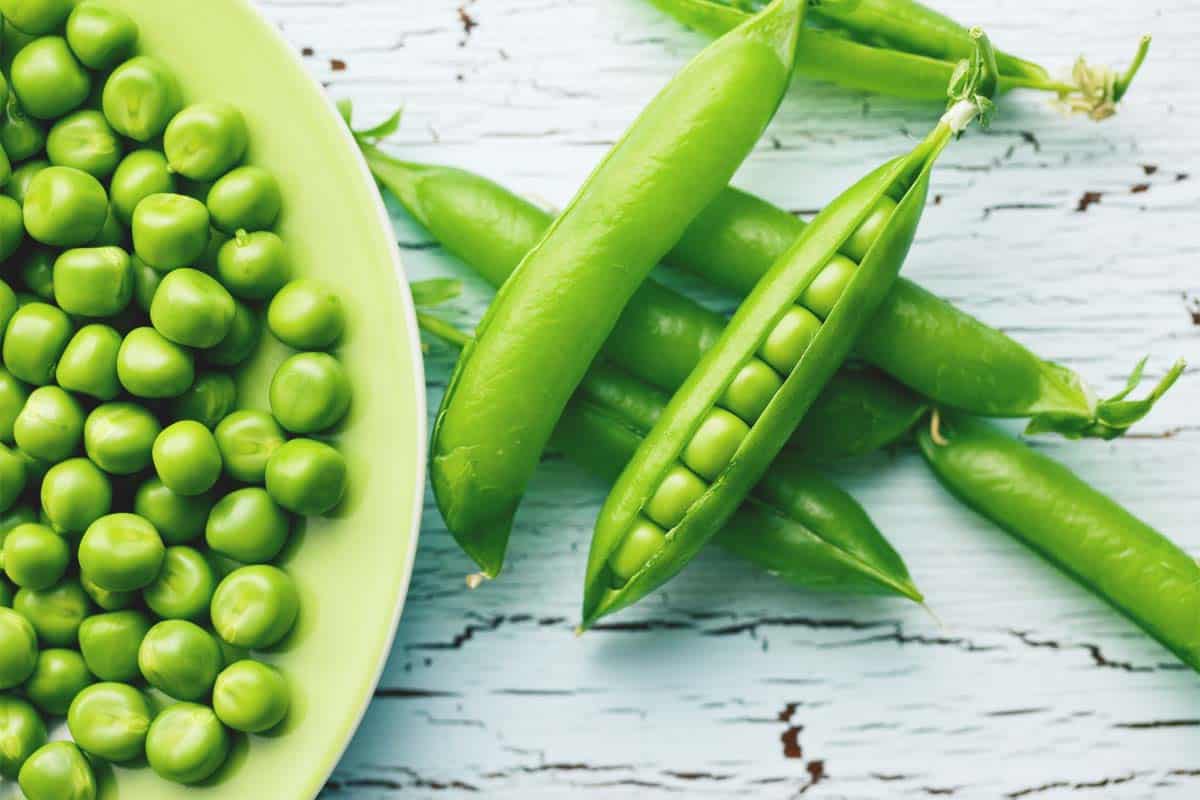Green beans and peas are two common vegetables that are often confused as being the same thing. However, there are some distinct differences between the two.
Classification
Green beans and peas belong to different botanical families, Green beans are a cultivar of the common bean plant (Phaseolus vulgaris) which is part of the Fabaceae family, Peas on the other hand belong to the Pisum genus and Faboideae subfamily
So while both are part of the larger Fabaceae family of plants, they belong to different genera. This means they have different physical characteristics and nutritional profiles
Physical Appearance
In terms of appearance, green beans and peas look quite different.
Green beans are long, slender pods that can range from 2 to 6 inches in length. The pods are generally straight with a smooth, rounded shape. Inside the pods are small oval-shaped seeds.
Peas on the other hand are small spherical seeds that grow inside pods. The pods are typically curved or straight and around 3-4 inches long.
So peas themselves are the seeds, while the beans are the actual pods.
Culinary Uses
Culinary-wise, green beans and peas have different uses.
Green beans are eaten as a whole vegetable – the pod and seeds inside are all edible. They can be eaten raw or cooked by blanching, steaming, sautéing etc. Popular dishes include green bean casserole and raw vegetable platters.
For peas, generally just the seeds are eaten. The pods are removed and discarded during harvesting or prep. The tender sweet peas are used in foods like pea soup, fried rice, pasta dishes and more. An exception is snap peas where the crisp, edible pods are also eaten.
So while both veggies are versatile, the part of the plant consumed differs.
Nutritional Profile
When it comes to nutrition, green beans and peas vary in their macro and micronutrient contents.
For macros, peas contain more than double the amount of carbohydrates and protein compared to green beans. They also contain more calories per serving.
However green beans contain a bit more fat, mainly in the form of healthy unsaturated fats. They are also significantly higher in dietary fiber.
For micronutrients, peas contain more of certain vitamins like vitamins A, C, B1 and B6. Green beans on the other hand have higher levels of antioxidants like vitamin E and K.
In terms of minerals, peas provide more iron, zinc, magnesium and phosphorus. But green beans contain greater amounts of calcium.
So while both offer important vitamins and minerals, their individual nutrient profiles differ.
Health Benefits
Despite their nutritional differences, green beans and peas share some similar health benefits.
Both are low in calories and high in fiber. This makes them useful for managing weight and promoting digestive health.
The antioxidants they contain can help reduce inflammation and oxidative stress. Their anti-cancer effects may also help protect against certain chronic diseases.
Additionally, the protein, vitamins and minerals in both support bone health, heart health and blood sugar regulation. The high fiber content also helps lower LDL cholesterol.
However, there are some unique benefits as well. The high vitamin K levels in green beans promote healthy blood coagulation. And the iron, zinc and B vitamins in peas support immune function and energy levels.
So while the veggies have overlapping benefits, they also each target certain aspects of health based on their individual nutrients.
Adverse Effects
There are a couple potential downsides to green beans versus peas.
Green beans contain lower amounts of antinutrients like phytic acid and lectins. This makes them easier to digest for some people.
Peas also contain FODMAPs, a group of carbs that can cause bloating issues in those with IBS. So green beans may be better tolerated by these individuals.
However, the phytic acid in peas has been shown to potentially reduce cancer progression. So some antinutrients also have protective effects.
Overall though, both veggies have minimal adverse effects for most people when eaten in moderation as part of a balanced diet.
Difference in Growing Conditions
Another key difference between green beans and peas is their optimal growing environments.
Peas prefer cool weather and can withstand some frost. Green beans grow better in warm conditions and hot weather.
This means peas can be planted earlier in spring while green beans are better suited for summer planting. Peas also reach maturity and are harvested earlier compared to green bean plants.
Additionally, pole bean varieties of green beans require trellising while pea plants typically do not. So the veggies have differing space and structural needs when farming.
Cost Differences
Due to higher yields, shorter growing cycle and less need for structural supports, peas tend to be more economical to grow than green beans.
This means that peas are often cheaper to purchase compared to green beans. However, pricing can also depend on whether fresh or frozen varieties are bought.
So when considering cost, peas generally provide more bang for your buck.
Culinary Substitutions
If you don’t have any green beans for a recipe, peas can work as a substitute in some cases. Their bright green color and mild flavor works well in many cooked dishes.
However, the texture will be quite different since peas are spherical. For salads and other raw applications, sliced snap peas or snow peas would be a better replacement.
Peas also work as an alternative to green beans in canned or frozen vegetable mixes. Their small size allows them to blend seamlessly into soups and stews.
So while not an exact match, peas can fill in for green beans nicely when used properly.
Are They the Same?
While green beans and peas share some similarities and overlap in benefits, they have distinct differences that set them apart. From plant taxonomy to physical form to optimal uses to nutritional profiles, the vegetables vary in many regards. Their unique growing needs and costs also demonstrate how they are their own entities.
However, both play an important role in a healthy diet and provide a range of valuable nutrients. Their complementary benefits demonstrate why it’s ideal to eat a diverse mix of plant foods. So while green beans and peas may look alike at first glance, upon closer inspection it’s clear they are their own vegetables with distinct attributes. The next time you’re choosing between the two for a recipe, consider their unique characteristics and uses.
Summary: The Differences Between Green Beans and Peas
- Belong to different botanical families and genera
- Have different physical forms (pods vs seeds)
- Are used differently in cooking
- Have varying macro and micronutrient profiles
- Offer some overlapping and some unique health benefits
- Have differing antinutrient/digestive effects
- Require different optimal growing conditions
- Vary in cost and economic yield
- Can substitute for one another in some recipes
- Ultimately are distinct vegetables with many differences
So in conclusion, while related, green beans and peas have enough distinct qualities to be considered separate vegetables rather than the same thing. Taking a closer look shows how their similarities end at a surface level, but they remain their own unique food.

How should I count beans, peas, and lentils?
Beans, peas, and lentils may be hard to count if you are using the MyPlate Plan to keep track of what you eat. Often, people who eat meat, poultry, and seafood would count beans, peas, and lentils in the Vegetable Group. If you get most of your protein from plants, you might want to put some or all of the beans, peas, and lentils you eat in the Protein Foods Group.
To learn what’s best for you, follow these steps:
- Keep track of how many ounces of protein-rich foods you’ve eaten that aren’t beans, peas, or lentils.
- Do you get the amount of protein you need from this group of foods? If so, count your beans, peas, and lentils as vegetables.
- If you haven’t met the Protein Foods Group’s suggested amount yet, count the beans, peas, and lentils you’ve already eaten as protein foods. You can count the extra as vegetables if you eat more than the recommended amount.
For a 2,000-calorie plan, the following examples use the level of 5 1/2 ounces suggested by the Protein Foods Group. 1.
Foods eaten from the Protein Foods Group
2 ounces tuna fish
½ cup black beans
In the Protein Foods Group, 3½ ounces of chicken and 2 ounces of tuna fish are equal to 5½ ounces, which is the right amount of food for this number of calories. This means the ½ cup of black beans can be counted as ½ cup-equivalent in the Vegetable Group. 2.
Foods eaten from the Protein Foods Group
1½ tablespoon peanut butter
The 2 eggs and 1½ tablespoon peanut butter equal 3½ ounce-equivalents in the Protein Foods Group. Two more ounces are needed to meet the 5½ ounce recommendation for this group. This means the ½ cup of chickpeas can be counted as 2 ounce-equivalents in the Protein Foods Group.

What are beans, peas, and lentils?
“Pulses” like beans, peas, and lentils are made up of dried legume seeds that can be eaten. They are a type of vegetable on MyPlate. “Legume” is the scientific term that describes a type of plant that includes pods. You can eat the seeds inside the pods of plants like beans, peas, and lentils. They are called “pulse.”
Beans (kidney beans, pinto beans, white beans, black beans, lima beans, fava beans, soy beans), dried peas (chickpeas, black-eyed peas, pigeon peas, split peas), and lentils are all in this group. Edamame, the soybean in the pod, is also in this group, even though it is eaten fresh instead of dried.
The nutrition of green peas and green (string) beans is more like that of foods in other vegetable subgroups, so they are not in this group. Green peas and green lima beans are in the Starchy Vegetables subgroup. Green (string) beans are in the Other Vegetables subgroup.
Visit the Vegetable Group page to learn more.
Let’s Settle the “Peas vs Beans” Debate Once and For All | Chefs Produce Co.
FAQ
What’s the difference between peas and green beans?
Are green beans just pea pods?
Why are peas called beans?
Can I substitute green beans for peas?
Are green beans and peas related?
Peas (Pisum sativum) belong to the Pisum genus and Faboideae subfamily. Green beans (Phaseolus vulgaris), also known as common, French, string, or snap beans, belong to the Phaseolus genus. Both peas and green beans belong to the flowering plants family Fabaceae or Leguminosae, also known as the legumes family.
What type of beans should one eat?
The most healthy beans are chickpeas, lentils, peas, kidney beans, black beans, soybeans, pinto beans, and navy beans. They contain a lot of fiber and proteins.
Are green beans better than peas?
In particular, peas are 2000 times richer in vitamin B5, almost 4 times richer in vitamins B1 and B6, 3 times richer in vitamin B3, and 2 times richer in vitamin B9 or folate. They also contain larger amounts of vitamins A, C, and B2. That being said, green beans provide 3 times more vitamin E and 2 times more vitamin K.
Are snap peas and green beans the same?
If you’ve ever found yourself pondering the similarities and differences between these two vegetables, you’re not alone. Snap peas and green beans are not the same. Snap peas, also known as sugar snap peas, are a cross between snow and garden peas. They have a crunchy texture and sweet flavor, and the whole pod is eaten.
